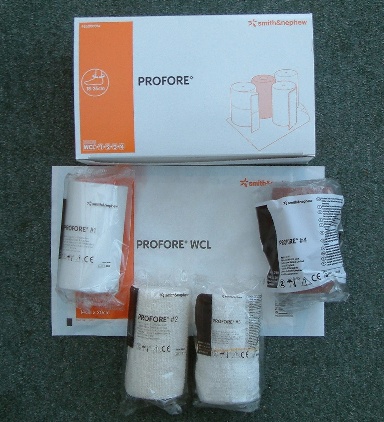
| Product Name: | Profore |
| Classification Name: | Multilayer Bandage Compression System |
| Manufacturer: | Smith & Nephew Healthcare Ltd |
Profore is a multi-layer compression bandage system for treating venous leg ulcers. Five kits are available which contain a number of different components, the choice of which is determined by the dimensions of the leg to which it is to be applied.

The standard Profore kit, for ankles 18-25cm in circumference, contains five components,
The primary purpose of this layer is to protect bony prominences from excess pressure, but it also serves as a secondary absorbent layer in the treatment of heavily exuding ulcers.
The compression produced by the bandage system is the sum of the individual pressures produced by each of the three extensible bandages.
Because sub-bandage pressure is directly proportional to bandage tension but inversely proportional to limb circumference, limbs of different sizes will require kits with different components to achieve clinically effective levels of compression
For legs with ankles less than 18cm circumference a kit with an additional padding layer (Profore #2) is available. For larger legs, a more powerful Type 3c compression bandage (Profore +) is recommended but for patients whose ulcers have an arterial component, Profore Lite, a kit without the compression bandage (Profore #3), should be applied.
Profore is used for the treatment of venous leg ulcers with a Doppler index reading of greater that 0.8. Profore Lite is indicated for mixed aetiology leg ulcers with a Doppler index reading of between 0.6 and 0.8 or for patients who cannot tolerate full compression.
Profore should not be used for the treatment of ischaemic limbs (Doppler index readings below the ranges stated above), diabetic patients with advanced small vessel disease, or in any other situation where sustained compression is contra-indicated.
Select a kit appropriate to the circumference of the ankle to be treated and follow the supplied instructions carefully.
Remove a primary dressing from its packaging and apply directly to the wound (additional dressings may be used for larger wounds). It does not matter which side is placed in contact with the wound bed.
With the primary dressing in place, apply the padding without any tension, working from the base of the toes to the knee. First wrap the padding around the foot, complete an ankle lock and take the padding around the back of the ankle and return across the top of the foot ensuring that the heel and foot are well covered. Proceed from the ankle to the knee using a simple spiral technique at 50% overlap. Cut off excess padding. If required strips of this excess material can be applied alongside the tibia or around the malleoli (ankle bones) to provide additional protection to these vulnerable areas.
For legs with ankles 18-25cm in circumferences, once the padding is in place, apply two turns of the Profore #2 around the base of the toes using minimal tension. Wrap the bandage around the foot, complete an ankle lock and take the bandage around the back of the ankle and return across the top of the foot to cover the padding. Continue to apply the bandage from the ankle to the knee using a simple spiral technique producing a 50% overlap with the bandage applied at mid stretch as described in the instructions supplied with the product. The bandage should be finished just below the level of the padding, any excess cut off and the bandage held in place with tape.
The Profore #3 is then applied, starting with two anchor turns at the base of the toes, followed by a heel lock as before. The bandage is then applied with a 50% overlap, facilitated by the central coloured line, using a figure of eight technique as described in the accompanying literature. The bandage is finished as before, any unused portion cut away and taped into position.
The final cohesive layer (Profore #4) is applied in exactly the same way as Profore #2 in a spiral with a 50% overlap not a figure of eight technique up to just below the knee, ensuring that the last 15cm of bandage is applied unstretched. Gentle pressure is then applied to the surface of the fabric to ensure the cohesive layers bind together.
Where clinically indicated, as in the treatment of larger legs, Profore+ is applied in the same way as Profore #2 at 50% stretch with a 50% overlap terminating just below the knee. Any excess bandage is cut off and secured with tape not wound around the leg.
Profore can be worn for up to 7 days, depending on the level of exudate. At the start of treatment it may be necessary to change the system more often as oedema initially reduces.
Profore should not be applied to patients with significant arterial impairment. Care must be taken to ensure that the various components of the system are applied exactly as directed in the instructions using a simple spiral with a 50% overlap unless otherwise directed. A figure of eight technique should not be used with Profore+ as this would result in more than two layers of fabric and the formation of excessively high levels of sub-bandage pressure.
The bandages are available in five kits as follows, for treating:
The bandage has a shelf life of three years from the date of manufacture.
Moffatt, C. J., Simon, D. A. et al. (1999). Randomised trial comparing two four-layer bandage systems in the management of chronic leg ulceration. Phlebology 14: 139-142.
Iglesias, C. P., Nelson, E. A. et al. (2004). Economic analysis of VenUS I, a randomized trial of two bandages for treating venous leg ulcers. Br J Surg. 91(10): 1300-6.
Further information on obtaining Smith & Nephew products is available on the
Smith & Nephew web site.
| Revision Author | Dr S. Thomas |
| Revision No | 1.4 |
| Revision date | 2006/01/26 |
This datacard has been prepared from data provided by the manufacturer and/or from published literature.